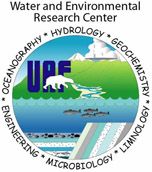

 |
 |
||
 |

Intersections of water, |
||
Current Infrastructure
Infrastructure impacts water use from the supply side. Piped delivery leads to greater domestic demand than when people haul water. Advanced treatment also makes otherwise unusable water a potential source. Water system infrastructure is sumamrized below for Seward Peninsula communities.
Elim's municipal water supply is pumped from pipes under Town Creek (right) or a shallow well nearby. Elim has 210,000 gallons of storage. Treated water is piped to homes. Elim has a population of about 300 (2005) and water use in 2004 was estimated at 72 gallons per capita per day (gpcpd).
Golovin's municipal supply comes from an infiltration gallery on Cheenik Creek (far left). The school storage tank (350,000 gallons, near left) is in addition to the city's 600,000 gallons of storage. The community is in the process of installing piped distribution to homes, so presently some residents have piped water, some have water delivered, and some collect their own water. The 2005 population in Golovin was about 150 and 2004 water use was an estimated 25 gpcpd.
Teller's municipal storage tank (upper right) is filled during the summer by truck. Coyote Creek (lower right) serves as the source for the school's water tank. Total storage in Teller is 1.1 million gallons. Teller's 2005 population was around 260 and the 2004 water use was estimated to be 10 gpcpd. White Mountain's municipal supply is a well. Treatment and storage facilities are shown (left). The tank holds 150,000 gallons. Water is piped to most households. The ~220 residents of White Mountain (2005) were estimated to use an average of 96 gpcpd (2004). Wales derives its municipal supply from Gilbert Creek (upper right) during the summer, filling a 500,000 gallon tank to last the winter. During the winter a common traditional source is Village Creek (lower right), where a hole is kept open in the ice. Two new wells have been drilled, but not connected to the water system. Residents haul water. About 150 people live in Wales (2005). Average water use was around 9 gpcpd (2004). Shishmaref, sitting on a small island, has limited freshwater resources. The washeteria, with a central watering point (upper left), is supplied from a lined catchment (lower left) in which snow is captured with the help of snow fences during the winter. 300,000 gallons of storage is available. Water is either hauled by residents or delivered to tanks in the homes. Shishmaref has around 580 residents (2005) and water use was estimated to be 8 gpcpd (2004). Deering derives its water supply from the Inmachuk River. Water is filtered (near right) and stored in a 400,000 gallon tank (far right). Total storage in Deering amounts to 420,000 gallons. Residents haul water or have it delivered to home storage tanks. Deering's population is around 140 (2005) and water use in 2004 was estimated to be 8 gpcpd. Nome's municipal water supply is derived from 3 wells in the area known as Moonlight Springs (upper left). UAF has been monitoring the water level in the wells since 2004 when these pressure transducers and datalogger were installed (left). Water is treated and stored in a 50,000 gallon tank and delivered to most residents. Some have water delivered by truck. A 1 million gallon tank provides a backup supply. Nome has a population around 3,500 (2005). Nome residents used an average of 105 gpcpd in 2004. Brevig Mission has a relatively new water system, completed in 2002. Water is piped from two wells (far right), filtered and chlorinated (near right), stored in a 100,000 gallon tank, which is filled monthly, and distributed to residents. Brevig Mission's 330 residents (2005) were estimated to use an average of 46 gpcpd (2004). Council no longer has a public water system. Individuals have wells or haul water. Council has no permanent population, but is used seasonally by residents of other Seward Peninsula communities, such as Nome. Infrastructure information is summarized from ADCA community profiles and project field visits.
This material is based upon work supported by the National Science Foundation under Grant No. OPP-0328686. Any opinions, findings, and conclusions or recommendations expressed in this material are those of the authors and do not necessarily reflect the views of the National Science Foundation. UAF is an affirmative action/equal opportunity employer and educational institution. The University of Alaska Fairbanks is accredited by the Northwest Commission on Colleges and Universities.
|
_